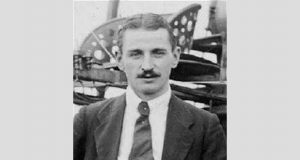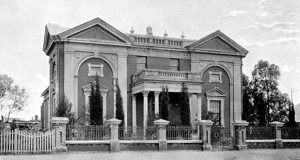UPDATED: 11/06/2025
11 June 1888, South Africa’s first War Memorial, the Beaconsfield Town Hall, opened.
Pictured is the original building shortly after the opening in 1888, as well as a postcard and photograph depicting the Hall in 1902 or shortly thereafter. All pics from the collection of the Kimberley Africana Library.
The Beaconsfield Town Hall
The Town Hall in Beaconsfield was a well-known landmark.
Built in three stages, the original building was opened on 11 June 1888 as a memorial to the Volunteer Forces of the Diamond Fields. The second stage was a new wing, celebrating the Diamond Jubilee of Queen Victoria, this being completed in October 1897. The final addition, and third stage, was the magnificent tower and clock that was built by 1902.
Over the decades the building had become dilapidated, and despite efforts to save it, it was demolished in 1969. (The cost in saving the building – a virtual rebuild of the hall – were astronomical, even for the time).
The bell, foundation stone and clock were donated by the Kimberley City Council to the Kimberley Regimental Association for safekeeping in 1976. Initially kept at the Dairy Farm (De Beers) they were later moved to the McGregor Museum.
The foundation stone is now in the precincts of the Kimberley Regiment, the clock and bell being in storage at the McGregor.
UPDATED: 11/06/2024
11 June 1888, South Africa’s first War Memorial, the Beaconsfield Town Hall, opened (pictured).
DID YOU KNOW
Part Two of the Kimberley Mine Disaster.
On Friday 9 June 1899 there occurred at the 1480 feet level of the Kimberley Mine an horrific explosion that killed 30 miners, 18 of whom were killed immediately while another 12 would succumb to their injuries over the following few weeks.
When the explosion happened the mine manager TJ Woodburne was also underground, but on a different level.
Blasting was done by contractors to the De Beers Mining Company, and the inquest held a few days after the terrible accident unfortunately shed little light on what had transpired as those closest were all killed or horribly injured.
But safety procedures would change with nearly immediate effect.
Boxes of dynamite were kept at the 1480 feet level, in a safe, cool and well ventilated section of the tunnel – in what was termed the dynamite magazine.
On this particular day there were five boxes of dynamite that were to be used for blasting and the mine workers, led by contractors, were carrying the said boxes to where they were going to be used. It is uncertain as to what then happened. It is presumed, remembering all around the immediate area were killed or died shortly afterwards, that a box was accidentally dropped.
This resulted in an explosion which sympathetically detonated all the boxes of dynamite with the resultant fatalities.
One white miner, Sidney Kenny of Knight Street, Kimberley, plus 18 (at this stage) unknown African miners, died immediately. Kenny in his spare time had been an enthusiastic rugby player for the Pirates Club XV as well as a volunteer soldier with B Company Kimberley Rifles. He had also fought in the Matabele War of 1896.
Reaction to the blast, which was heard above ground in the streets of Kimberley, was immediate.
Relief and rescue parties were organized by the mine manager Mr Woodburne and sent underground, passing on their way dozens of miners all dirtied and blackened with dust and smoke from the explosion all making their way to safety above ground. Doctors EO Ashe and JE MacKenzie were also underground within 30 minutes to render what first aid they could at the scene.
Seriously injured at or near the scene of the explosion were another 42 miners, 27 African and 15 white, most of whom were in critical condition. Two would die within hours, another ten over the following few days in hospital. Many would lose limbs. By 9 June there were 29 deaths, the 30th and final victim succumbing a few weeks later.
The storage of the dynamite underground was highlighted at the inquest and new regulations concerning this practice were introduced shortly after the tragedy. No longer would dynamite be stored underground but would be brought down on a daily basis when needed. It would also be carried in a strong and specially constructed metal container on a cocopan chassis. While still not guaranteeing no premature explosion, it did eliminate any possible human error in transporting dynamite to where it would be used in the mine.
May all those who died from the explosion that day in the Kimberley Mine rest in peace.
11 June 1888, South Africa’s first War Memorial, the Beaconsfield Town Hall, opened (pictured).
DID YOU KNOW
By Frances Baard
My father, Herman Maswabi, was a well-educated man. He came from Ramotswa in Bechuanaland, to Kimberley to find work on the mines. It was there that he met my mother, Sarah Voss. She was a Tswana like him, but she was from Kimberley. They got married there, and then they had us children.
We were six children all-together, four girls and two boys. The first-born was Leah, and the next one too was a girl, Regina. Then came Nicodemus, the first son. Nicodemus and me always got on very well, and even now we still go along together fine. He is still alive now, even though he is very old. He is about six years older than me. I was the next one after him. I think it was October 1908 that I was born, but I never saw my birth certificate or anything. My parents called me Frances Goitsemang. Goitsemang means ‘who knows?’ My sister, the one before me, was much older than me so when I was born my parents called me ‘who knows?’ ‘Who knows that we are going to have another daughter!’ After me came Adelaide. She was the youngest girl in the family. Then, the youngest one was Elijah. Those two boys, Nicodemus and Elijah, hawu! They used to fight a lot. But the girls, we got on very well with each other.
We used to live in quite a big house, six rooms or so, seven with the kitchen. My father built it himself and it was a very nice house. But it was just a simple place too. We didn’t have electricity there. There was a tap in the yard and we used to fetch water from that tap to take inside for washing and cooking and everything. But we had a little garden in the yard, and we had some flowers and some vegetables growing there. Us children used to take a little water in a bucket every day to water the garden.
Every Sunday we put on our special clothes so we look very pretty and then we go to church, the whole family. My father was a steward in that Methodist church. I used to enjoy it a lot. I like singing, and the hymns were very nice. And there was no other place we could go to, only church! From there we would go out in the afternoon. We had an uncle who was the only brother of my mother, and he was so fond of us. In the afternoon after church we used to go and visit him. Every time he would give us some monies and we go buying sweets and so forth. Sunday was a nice day because you know you are going to get some money from uncle.
My parents’ house was in Beaconsfield, in Greenpoint township just outside Kimberley. Beaconsfield is not a very big place. You know when you go out from Cape Town you get all those little places like Worcester, well, Beaconsfield was just like one of those small places. We used to have to travel by bus or train when we wanted to go to Kimberley.
I started to go to school in Kimberley. It was also a mission school like the one in Ramotswa, but my parents were not Lutheran, they were Methodist, so it was a Methodist school. It was very nice at that school. They used to teach us in English and Tswana. Those that talk in English at home; they were taught in English, and those who spoke Tswana, they were taught in Tswana. So I studied at that school. My parents were very good, they looked after us very well, and they educated all us children too.
During this time that I was at school, when I was about nine, or maybe ten, my mother passed away. That was a very sad thing, and I was still so little. Adelaide and Elijah were even younger. It was during the start of that ‘flu, and I think it was the ‘flu that killed her. That changed things a bit. I was just left with my father, my brothers and sisters who were not yet married. For six months after that we all wore black in mourning for my mother.
My one sister was married already by that time. She used to teach at the mission school that I went to in Beaconsfield, and there she met the principal of the school, and they got married. After a while I was the only one who was staying in that big house in Beaconsfield with my father. The two of us stayed together and I went to school there.
I liked that school a lot. There were many things to do at school. I remember we used to play tennis and netball. I was very fond of playing tennis. I even used to play it after school. I used to sing a lot too. There was one song, which I liked particularly. When I was in standard six I went to another school at Lyndhurst Road, at a place called Malay Camp. It’s a place where the Malays used to stay, and so it was called Malay Camp. I got very sick when I was there at that school. I really forget what was wrong with me, but I was very sick. While I was so sick, I called my teacher ‘Please call my classmates to come and sing that song.’ I wanted to hear them sing that song I liked so much. I don’t know why they delayed, whether they thought I was going to die or what, or if they delayed on purpose, or if they couldn’t get the children together, but they never came to sing that song for me. That was a song! It was called Rock of Ages. I liked that song very much.
When I passed standard six, my father sent me to Perseverance Training School where they used to train teachers. They used to give lessons there in teaching the lower classes. I passed my first year there, and I started my second year. I was 16 years, 16 or 17 at that time. I was learning very well, but then during my second year, my father passed away.
Then I had no home in Kimberley anymore, so I went to live with my sister for a time. Then her husband, the one who was the principal of the school I used to go to, he got a post for me to go and teach at a place called Pardieberg. It’s somewhere in the Free State. You go out from Kimberley, and when you get into the Free State, it is just there.
(From “My Spirit Is Not Banned” by Frances Baard and Barbie Schreiner, published in 1986.)
From Kimberley Calls and Recalls on Facebook By Steve Lunderstedt
Shortlink for this post: https://www.kimberley.org.za/?p=9338







